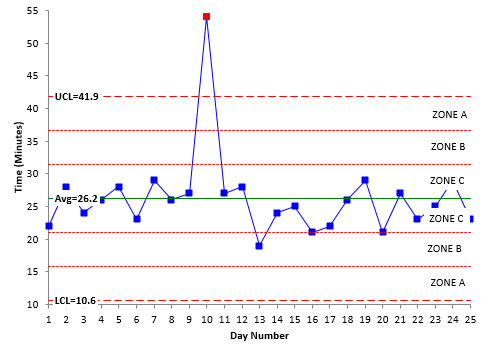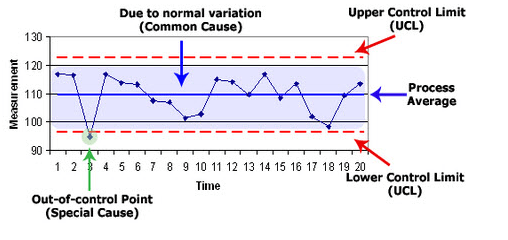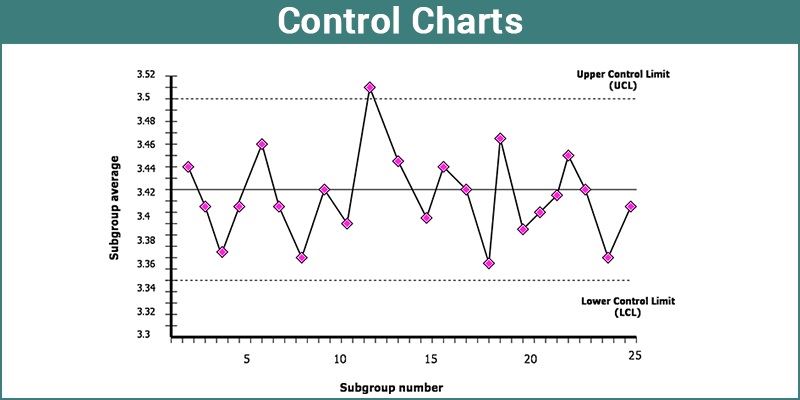Control Charts Are Used to Check Which of the Following
We could go on and on. Used to monitor the dispersion of a process.

Control Chart Rules And Interpretation Bpi Consulting
Charts for variable data are listed first followed by charts for attribute data.

. Where do you use control charts. The u-chart is a quality control chart used to monitor the total count of defects per unit in different samples of size n. Data are plotted in time order.
A Record the header information at the top of the sheet B Calculate the sum average and range of the sample C Plot the average and range values on the chart D Enable a set. The first referred to as aunivariate control chart is a graphical display chart ofonequality characteristic. There is another chart which handles defects per unit called the u chart for unit.
It helps us to keep an eye on the pattern over a period of time - variation quantity the current capability of your process and identify when some special events interrupt the normal operations. The purpose of a control chart is to set upper and lower bounds of acceptable performance given normal variation. The most common limits used on control charts is 3 times the standard deviation.
The most common application is as a tool to monitor process stability and control. The control chart is a graph used to study how a process changes over time. 2 for monitoring process variation over time.
Additionally the limits on your control chart depend on the type of control chart that you need to use. Keep those Six Sigma DMAIC Improvements. Dependingon the number of process characteristics to be monitored there aretwo basic types of control charts.
Shewhart chart statistical process control chart. The charts are segregated by data type. Control charts alone can determine the source of problems.
Which of the following best describes the range of the control limits applied on a control chart. The proportion of defective items generated by a process. 1 for presenting process performance in a quick and easy-to-use visual format.
Control charts dealing with the number of defects or nonconformities are called c charts for count. Which of the following pairs is the most useful in preparing control charts when used together for variables data. X-bar chart Delta chart evaluates variation between samplesNon-random patterns signals in the data on these charts would indicate a possible change in central tendency from one sampling period to the next.
A control chart is used. This chart is a graph which is used to study process changes over time. The following table may be utilized to help select an appropriate control chart for each application.
The second referred to asa multivariate control chart is a graphical display of a statisticthat summarizes. These charts are also known as Shewhart charts or process-behavior charts. An X-bar and R chart is represented best by variables data.
There are two main types of variables control charts. Control charts can be used to monitor a process for the existence of. Control charts are a great tool to monitor your processes overtime.
Options a and b list attribute data quantities. A p-charts B R-charts OC X-bar charts OD C-charts Used to monitor the number of defective items in a process. In an earlier post I wrote about the common elements that all control charts share.
This applies when we wish to work with the. A control chart always has a central line for the average an upper line for the upper control limit and a lower line for the lower control limit. Control charts have two general uses in an improvement project.
This way you can easily see variation. Control charts are used to routinely monitor quality. Control Chart shows the upper and lower statistical control limits as well as the average for samples or subgroups of a given processIn the event that all points on the control chart are within the control limits variations can be attributed to a single cause and the process is considered to be in control.
A time-ordered plot of sample statistics used to determine randomness or non-randomness. X-bar and R. 3 for distinguishing out-of-control points due to special assignable causes from variations due to common causes that are part of the process.
The major components of a control chart are the lower control limits and the center line and the upper control limits. The reality is that any process repeated on a regular basis can be monitored using a control chart. Steven Wachs Principal Statistician Integral Concepts Inc.
A step that is not used by an operator to manually record data for a control chart is _____. 4 for detecting abnormal trends and other tell-tale signs of process anomaly. In statistics Control charts are the tools in control processes to determine whether a manufacturing process or a business process is in a controlled statistical state.
Control charts are used to determine the stability of a process. For more information on setting limits on your control chart I highly. The y-axis shows the number of defects per single unit while the x-axis shows the sample group.
If a point is out of the control limits it indicates that the mean or variation of the process is out-of-control. What type of control chart is used to monitor the number of defects per unit. Time to admit a patient.
The control limits on both chats are used to monitor the mean and variation of the process going forward. Time spent waiting for the doctor. The x-bar and R-chart are quality control charts used to monitor the mean and variation of a process based on samples taken in a given time.
In the Improve phase Control Charts are used to see the process improvement. Control charts are a key part of the management reporting process that have long been used in manufacturing stock trading algorithms and process improvement methodologies like Six Sigma and Total Quality Management TQM. A less common although some might argue more powerful use of control charts is as an analysis tool.
It assumes that units can have more than a single defect. Control charts are simple but very powerful tools that can help you determine whether a process is in control meaning it has only random normal variation or out of control meaning it shows unusual variation probably due to a special cause. Select the best definition of a control chart.
Control Charts Project Tools Six Sigma. Control charts are a great tool that you can use to determine if your process is under statistical control the level of variation inherent in the process and point you in the direction of the nature of the. Another great use of control charts is in health care.
So the question of the day for you is. Control charts dealing with the proportion or fraction of defective product are called p charts for proportion. Check all that apply OA p-chart B R-chart C X-bar chart D C-chart Which of the.
A C-charts B p-charts C X-bar charts D R-charts Which of the following control charts use attributes. What type of control chart is used for variables. The descriptions below provide an overview of the different types of control charts to help practitioners identify the best chart for.
Control Charts are used to focus on detecting and monitoring the process variation over time. Managers must make a number of important decisions about the use of.

Control Charts Types Of Control Charts And Features
Comments
Post a Comment